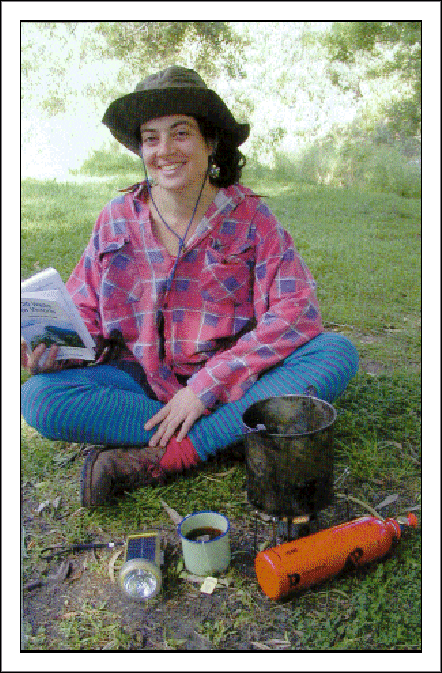

If you like to tread where few have gone before, you can lighten your ecological footprint by using renwable energy along the way
Most Australian National Parks do not permit visitors to collect firewood from within their boundaries, and while many permit fires with wood collected from elsewhere, the trend is towards no campfires of any kind. This means that if you want a cup of tea or a hot meal while you’re camping, you’re going to have to carry either a solar cooker or some kind of portable fuel stove.
Most of my outdoor travelling involves cycle touring or hiking, so one of the many folding reflective solar cookers isn’t really an option. While these are a great idea, they’re limited to daytime cooking, and in southern Australia, use during the summer. I’m usually not in one place for very long during the day, and like a cup of tea and a hot meal at night.

I own an MSR Dragonfly stove—a single burner with a refillable liquid fuel bottle. The bottle has a pressure pump on the lid, which forces fuel through a jet where it ignites and gives off a surprising amount of heat. I have mainly used it with Shellite, or distilled petroleum, but it can be used with kerosene, petrol, aviation gas and diesel.
While the stove doesn’t use a large amount of fuel (around a litre for two weeks of cooking), it bothers me that I am using fossil fuels to make my meals in the middle of the wilderness. There is also the issue of the inevitable drips of fuel from the fuel line giving clothes and food in my pack an unpleasant aroma, not to mention the odd splash that gets on your hands when packing up.
At the same time that these frustrations were mounting, we were doing a lot of research at ReNew into how waste vegetable oil is currently being used as a fuel in Australia. One of these applications appeared in the last issue in the story on the Veggie Oil Powered Tractor. Alongside this was an article on making biodiesel, a vegetable oil-based replacement for diesel. These articles inspired me to solve my problems with my fuel stove, and I gathered the ingredients for a small batch of biodiesel.
For my small batch, I purchased two litres of ‘No Name’ blended edible vegetable oil, which was the cheapest available. I also bought a 500 gram container of caustic soda from the supermarket cleaning products section. A friend who works in a laboratory was able to obtain 400ml of methanol, but I also tracked down some motor sports suppliers who sell it as ‘Racing Fuel Number 6’—they were fairly easy to find in the Yellow Pages.
Following the instructions in ReNew, my first attempt at biodiesel worked well. It did seem strange that a fairly odourless substance could replace diesel though!
Fuel stoves work by forcing a liquid fuel into a hot tube below the burner where it becomes gaseous and ignites as it is sprayed out of the jet. This gasification allows the stoves to burn fairly efficiently and cleanly—much more so than if a liquid were being burnt.
In order to get this gasification process started, it is necessary to ‘prime’ the cold stove by releasing a small amount of liquid fuel through the jet and allowing it burn on and around the inlet tube. Once hot, the stove can be turned on and the tube remains heated. With volatile fuels like Shellite, this is a simple process and takes only a few seconds, but with biodiesel it is not so simple.
Like diesel, cold biodiesel does not ignite instantly. My first attempt at getting the stove going was not too successful, as I released too much fuel for priming. The result, when I finally got it lit, was a pool of flaming biodiesel in the stove’s drip tray that took several minutes to burn out. This did successfully prime the stove though, and it boiled a billy full of water with a roaring orange flame in a few minutes.
I have refined the priming process by using a kerosene lamp wick to get the flame started. This is much better than using a match or twigs, which are more likely to clog the jet with ash.
Another slight inconvenience with biodiesel is that, despite priming, it does leave more deposits than a more volatile fuel. This simply means that the jet needs to be cleaned more often, though this only takes a few minutes.
For my next batch of biodiesel I plan to use recycled vegetable oil, making it both a renewable and recycled fuel. R

Michael Linke
Cooking in the bush with biodiesel, a diesel substitute made from vegetable oil. The advantages are that biodiesel burns a lot cleaner than diesel, does not have an unpleasant odour if it spills in your pack, and is made from a renewable resource. The disadvantages are that it clogs the stove’s jet more rapidly than fuels like Shellite, and it is harder to prime the stove.
You may also be interested in these following BIO FUEL webpages as well
This article and pictures originally appeared in The Renew magazine January March 2000
